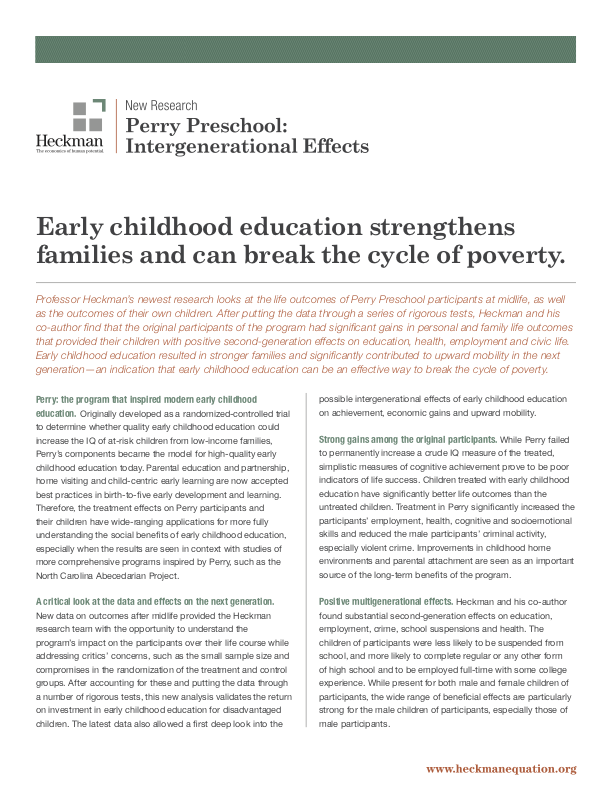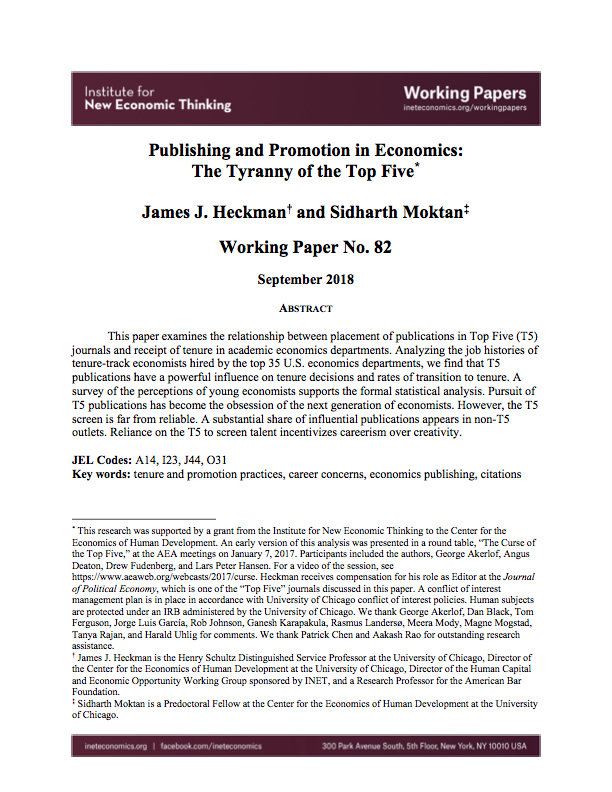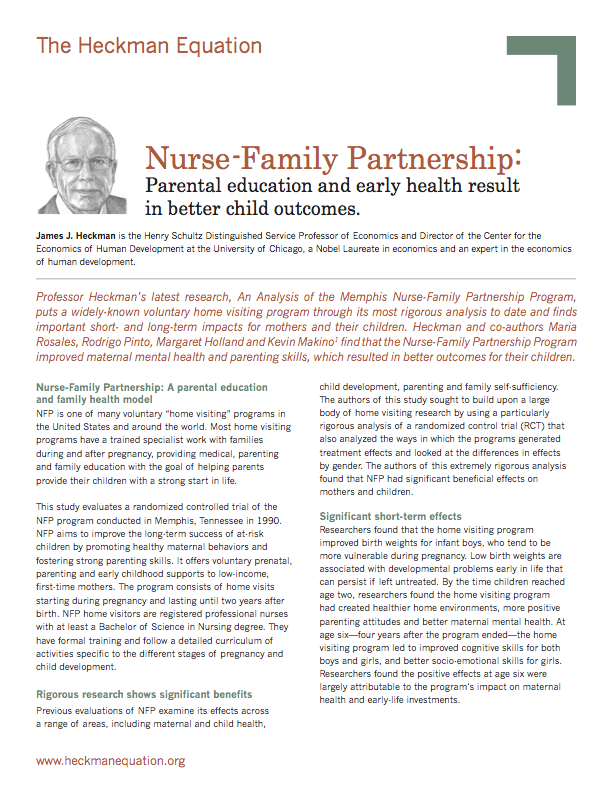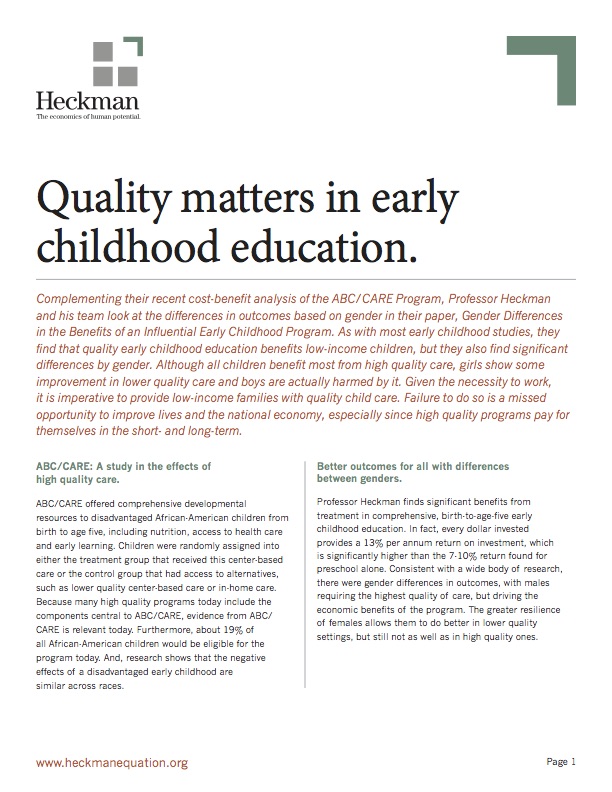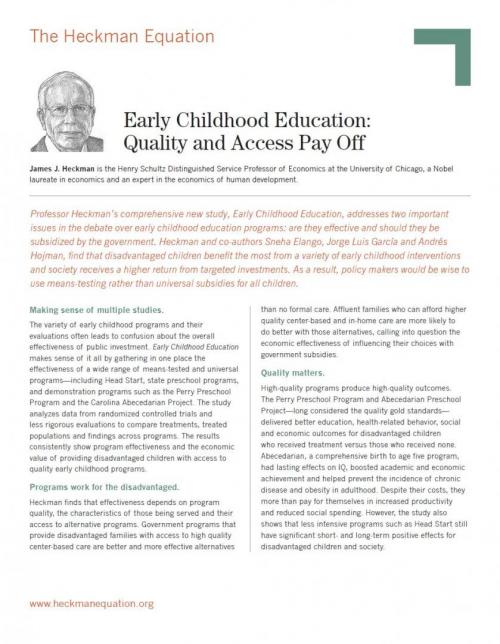Featured and Key Publications
Cognitive, psychosocial, and behaviour gains at age 31 years from the Jamaica early childhood stimulation trial
Abstract
Background: There is little evidence on adult benefits from early childhood interventions in low and middle-income countries. We assessed adult cognition, psychosocial skills, and behaviour from a stimulation trial conducted in Jamaica.
Methods: Children with stunted growth (height-for age <-2SD of references)aged 9-24 months were enrolled in a two-year randomised-controlled trial of nutritional supplementation and/or stimulation. At mean age 31.79 (SD 0.40)years, 95 of 127 participants (74.8%; 53.7% male) were assessed. Children without stunted growth were also followed as a comparison group (64 of 84 participants, 76.2%). Measurements included IQ, executive function, mental health, psychosocial skills, personality traits, and risk behaviours. A block permutation test, valid for small sample sizes, was used. Analyses accounted for the randomisation protocol, multiple hypothesis testing, and attrition.
Results: Treatment group participants (stimulation intervention with or without supplementation, n=48) had significantly greater IQ (Hedges g effectsize 0. 57;95%CI 0.20,0.95) and cognitive flexibility (0.61; 0.25,0.98) compared with no-treatment (no-intervention and supplementation only, n=47). They also had reduced depressive symptoms (0.61;0.28,1.00), increased grit (0.53;0.16,0.92), and conscientiousness (0.66;0.31,1.07), lower substance use (rank mean score, 0.45;0.08,0.81), and risk taking related to health and work (0.64;0.27,1.00). There were 18 significant 2 outcomes of 33 assessed. Comparison participants had higher IQ than no-treatment (1.17;0.81,1.54) and treatment groups (0.62;0.18,1.07); and better executive function, lower social inhibition, and risk taking than the no-treatment group.
Conclusions: The wide-ranging benefits at 31 years from the stimulation intervention supports investment in larger scale programmes to promote early childhood development in disadvantaged children. The lower IQ in the treatment group compared with comparison participants, emphasises the need for continued efforts to prevent early childhood growth retardation.
The Lasting Effects of Early Childhood Education on Promoting the Skills and Social Mobility of Disadvantaged African Americans
Abstract
This paper demonstrates multiple beneficial impacts of a program promoting intergenerational mobility for disadvantaged African-American children and their children. The program improves outcomes of the first-generation treatment group across the life cycle, which translates into better family environments for the second generation leading to positive intergenerational gains. There are long-lasting beneficial program effects on cognition through age 54, contradicting claims of fadeout that have dominated popular discussions of early childhood programs. Children of the first-generation treatment group have higher levels of education and employment, lower levels of criminal activity, and better health than children of the first-generation control group.
The Dynastic Benefits of Early Childhood Education
Abstract
This paper monetizes the life-cycle intragenerational and intergenerational benefits of the Perry Preschool Project, a pioneering high-quality early childhood education program implemented before Head Start that targeted disadvantaged African-Americans and was evaluated by a randomized trial. It has the longest follow-up of any experimentally evaluated early childhood education program. We follow participants into late midlife as well as their children into adulthood. Impacts on the original participants and their children generate substantial benefits. Access to life-cycle data enables us to evaluate the accuracy of widely used schemes to forecast life-cycle benefits from early-life test scores, which we find wanting.
Lessons from Denmark about Inequality and Social Mobility
Resources
Press
"Joe Biden wants to make college free. Denmark shows that won’t be enough" Quartz. March 26, 2021. Samanth Subramanian
"We have underestimated how important our family background is" Berlingske (DK). March 16, 2021. Bent Winther
"Family background shapes children’s lives despite different social policies in U.S., Denmark" UChicago News. March 15, 2021. Max Witynski
Abstract
Many American policy analysts point to Denmark as a model welfare state with low levels of income inequality and high levels of income mobility across generations. It has in place many social policies now advocated for adoption in the U.S. Despite generous Danish social policies, family influence on important child outcomes in Denmark is about as strong as it is in the United States. More advantaged families are better able to access, utilize, and influence universally available programs. Purposive sorting by levels of family advantage create neighborhood effects. Powerful forces not easily mitigated by Danish-style welfare state programs operate in both countries.
Treatment Effects and the Measurement of Skills in a Prototypical Home Visiting Program
Resources
Press
"Treatment effects and the measurement of skills in a prototypical home visiting programme" VoxEU. August 21, 2020.
Abstract
This paper evaluates the causal impacts of an early childhood home visiting program for which treatment is randomly assigned. We estimate multivariate latent skill profiles for individual children and compare treatments and controls. We identify average treatment effects of skills on performance in a variety of tasks. The program substantially improves child language and cognitive, fine motor, and social-emotional skills development. Impacts are especially strong in the most disadvantaged communities. We go beyond reporting treatment effects as unweighted sums of item scores. Instead, we examine how the program affects the latent skills generating item scores and how the program affects the mapping between skills and item scores. We find that enhancements in latent skills explain at least 90% of conventional unweighted treatment effects on language and cognitive tasks. The program enhances some components of the function mapping latent skills into item scores. This can be interpreted as a measure of enhanced productivity in using given bundles of skills to perform tasks. This source explains at most 10% of the average estimated treatment effects.
Intergenerational and Intragenerational Externalities of the Perry Preschool Project
Resources
Press
"The benefits of pre-schooling may extend for generations" The Economist. June 11, 2019.
"Business Matters: BBC World Service (at 36:15)" BBC. June 10, 2019.
"This is how quality early education can cross generations" World Economic Forum. May 29, 2019.
"New research finds benefits of landmark Ypsilanti preschool project are multigenerational" MPR. May 28, 2019. Stateside Staff.
"Since The 1960s, Researchers Track Perry Preschool Project Participants" NPR Morning Edition. May 23, 2019. Shankar Vedantam.
"Investir em educação para a primeira infância é melhor 'estratégia anticrime', diz Nobel de Economia" BBC Brazil. May 21, 2019. Luiza Franco.
"Preschool Can Benefit Poor Children's Families for Generations: Study" Global Citizen. May 17, 2019. Leah Rodriguez.
"The benefits of quality preschool for poor kids may extend to their children" Quartz. May 16, 2019. Annabelle Timsit.
"How Preschool May Benefit Generations Of Families" WBEZ. May 16, 2019. Nereida Moreno.
"Research Finds Early Childhood Education Strengthens Families" WTTW. May 16, 2019. Kristen Thometz.
"50 Years After Perry: Quality Early Childhood Has Second Generation Effect, Study Finds" The Chronicle of Social Change. May 14, 2019. Jeremy Loudenback.
"New research shows enduring payoff from preschool" Atlanta Journal Constitution. May 14, 2019. Ty Tagami.
"Preschool has enduring benefits for disadvantaged children — and their children, new research finds" Chalkbeat. May 14, 2019. Ann Schimke.
"Sending your boy to preschool is great for your grandson, new research shows" The Hechinger Report. May 14, 2019. Lillian Monegeau.
"Like Father, Like Son: Preschool Benefits Cross Generations, Says Landmark Study" Education Week. May 14, 2019. Sarah D. Sparks.
"Study finds breaking cycle of poverty could start in preschool classroom" WTOP. May 14, 2019. Rachel Nania.
"Long-Term Study Shows Free Pre-K Helps Low-Income Students, And Their Children" The Wall Street Journal. May 14, 2019. Leslie Brody.
"Politico Morning Education" Politico. May 14, 2019. Nicole Gaudiano.
"Perry Preschool study shows early ed benefits extend to participants' children, siblings" Education Dive. May 14, 2019. Linda Jacobson.
"Preschool education can benefit generations of families" UChicago news. May 14, 2019. Jack Wang.
Abstract
This paper examines the impact of the iconic Perry Preschool Project on the children and siblings of the original participants. The children of treated participants have fewer school suspensions, higher levels of education and employment, and lower levels of participation in crime, compared with the children of untreated participants. Impacts are especially pronounced for the children of male participants. These treatment effects are associated with improved childhood home environments. The intergenerational effects arise despite the fact that families of treated subjects live in similar or worse neighborhoods than the control families. We also find substantial positive effects of the Perry program on the siblings of participants who did not directly participate in the program, especially for male siblings.
The Perry Preschoolers at Late Midlife: A Study in Design-Specific Inference
Abstract
This paper presents the first analysis of the life course outcomes through late midlife (around age 55) for the participants of the iconic Perry Preschool Project, an experimental high-quality preschool program for disadvantaged African-American children in the 1960s. We discuss the design of the experiment, compromises in and adjustments to the randomization protocol, and the extent of knowledge about departures from the initial random assignment. We account for these factors in developing conservative small-sample hypothesis tests that use approximate worst-case (least favorable) randomization null distributions. We examine how our new methods compare with standard inferential methods, which ignore essential features of the experimental setup. Widely used procedures produce misleading inferences about treatment effects. Our design-specific inferential approach can be applied to analyze a variety of compromised social and economic experiments, including those using re-randomization designs. Despite the conservative nature of our statistical tests, we find long-term treatment effects on crime, employment, health, cognitive and non-cognitive skills, and other outcomes of the Perry participants. Treatment effects are especially strong for males. Improvements in childhood home environments and parental attachment appear to be an important source of the long-term benefits of the program.
Intergenerational Effects of Early-Life Advantage: Lessons from a Primate Study
Abstract
This paper uses three decades of studies with Rhesus monkeys to investigate the intergenerational effects of early life advantage. Monkeys and their offspring were both randomly assigned to be reared together or apart from their mothers. We document significant intergenerational effects of maternal presence. We also estimate, for the first time, the intergenerational complementarity of early life advantage, where the intergenerational effects of maternal rearing are only present for offspring that were mother-reared. This finding suggests that parenting is the primary mechanism driving the intergenerational effects. Our paper demonstrates how studies of primates can inform human development.
Publishing and Promotion in Economics: The Tyranny of the Top Five
Resources
Press
"Is publication in the T5 synonymous with career success for academic economists?" Monthly Labor Review, Bureau of Labor Statistics. December, 2018. John C. Roach.
"Economists care about where they publish—to the cost of the profession" The Economist. October 06, 2018.
"Pressure to publish in top journal stifles creativity in economic research, study shows" Phys.org. October 2, 2018.
"The Tyranny of the Top Five Journals" Institute for New Economic Thinking Blog Post. October 02, 2018. James J. Heckman and Sidharth Moktan.
"Why complain about top-5 journals? (Opinion)" The Chronicle of Higher Education. October 30, 2018. T. Koenig.
"UChicago Econ Paper: 'The Tyranny of the Top Five'" The Chicago Maroon. October 25, 2018. Y. Li.
"Study: Pressure to publish in top journals stifles creativity in economic research" UChicago News. October 1, 2018. J. Wang.
"How Much Does Publishing in Top Journals Boost Tenure Prospects? In Economics, a Lot" The Chronicle of Higher Education. October 1, 2018. A. Williams June.
Abstract
This paper examines the relationship between placement of publications in Top Five (T5) journals and receipt of tenure in academic economics departments. Analyzing the job histories of tenure-track economists hired by the top 35 U.S. economics departments, we find that T5 publications have a powerful influence on tenure decisions and rates of transition to tenure. A survey of the perceptions of young economists supports the formal statistical analysis. Pursuit of T5 publications has become the obsession of the next generation of economists. However, the T5 screen is far from reliable. A substantial share of influential publications appears in non-T5 outlets. Reliance on the T5 to screen talent incentivizes careerism over creativity.
Quantifying the Life-cycle Benefits of an Influential Early Childhood Program
Resources
Press
"The most important year in a child’s life? Research points to preschool" WTOP. September 21, 2017. Rachel Nania.
"In West Pottsgrove, pre-K advocates press for increased state funding" The Mercury. September 20, 2017. Evan Brandt.
"Commentary: The future rests with Utah’s youngest residents — so expand the Child and Dependent Care Tax Credit" The Salt Lake Tribune. September 10, 2017. Kris Perry.
"HIGH-QUALITY EARLY LEARNING AND CARE DRIVES LIFELONG SUCCESS" U.S. Congress Joint Economic Committee. September, 2017.
"Why your children’s day care may determine how wealthy they become" The Washington Post. April 24, 2017. Danielle Paquette.
"New York City Will Offer Free Preschool for All 3-Year-Olds" The New York Times. April 24, 2017. Kate Taylor.
"How Child Care Enriches Mothers, and Especially the Sons They Raise" The New York Times. April 20, 2017. Claire Cain Miller.
"Morning Report" Politico. December 12, 2016. Caitlin Emma.
"High ROI: Why preschool programs are a good investment for society" The Christian Science Monitor. December 12, 2016. Amanda Hoover.
"Why Doesn't Public School Start at Birth?" The Atlantic. December 12, 2016. Emily DeRuy.
"Preschool brings bigger than expected economic returns, economists say" Southern California Public Radio. December 12, 2016. Deepa Fernandes.
"How Investing In Preschool Beats The Stock Market, Hands Down" NPR. December 12, 2016. Eric Westervelt.
"Public Preschool Education That Starts at Birth Would Be Better for the Economy, According to New Research" New York Magazine. December 12, 2016. Lisa Ryan.
"A Nobel Prize winner says public preschool programs should start at birth" The Washington Post. December 12, 2016. Emma Brown.
Abstract
This paper quantifies and aggregates the multiple lifetime benefits of an influential high-quality early childhood program with outcomes measured through midlife. Guided by economic theory, we supplement experimental data with non-experimental data to forecast the life-cycle benefits and costs of the program. Our point estimate of the internal rate of return is 13.7% with an associated benefit/cost ratio of 7.3. We account for model estimation and forecasting error and present estimates from extensive sensitivity analyses. This paper is a template for synthesizing experimental and non-experimental data using economic theory to estimate the long-run life-cycle benefits of social programs.
An Analysis of the Memphis Nurse-Family Partnership Program
Resources
Press
"Amputee mom learns to care for baby with help from program" NOLA, The Times-Picayune. October 12, 2017. Celeste Turner.
"Home visiting has bipartisan support. So why did the federal program lapse?" Education Week. October 1, 2017. Christina Samuels.
"Nurse-Family Partnership Program supports first-time mothers" The Columbian. September 30, 2017. Marissa Harshman.
"If Congress can't agree on kids' health, then D.C. is more broken than we though" The Salt Lake Tribune. September 30, 2017. Robert Gehrke.
"Vista Unified's P-3 continuum: Closing the achievement gap before it opens" Education Week. September 28, 2017. Matt Doyle.
"New Orleans mayoral candidates must commit to invest in our young children" The Times-Picayune. September 27, 2017. Ron McClain.
"With deadline days away, fixes floundering for federal health, early ed programs serving 9M kids" The 74. September 27, 2017. Carolyn Phenicie.
"Clock ticking on federal funding for CHIP, other health safety net programs" Pittsburgh Post-Gazette. September 26, 2017. Kate Giammarise.
"Funding for home visiting set to expire, leaving early-intervention services in limbo for many" The Washington Post. September 22, 2017. Michael Alison Chandler.
"Time runs low for home-visiting act as Congress debates state buy in" Education Week. September 19, 2017. Christina Samuels.
"MIECHV match: House GOP gambles home visiting expansion on state’s ponying up" The Chronicle of Social Change. September 18, 2017. John Kelly.
"Close the preschool gap" U.S. News & World Report. Sept. 7, 2017. Sara Mead.
"Strong roots: Home visiting programs expand medical home into communities" AAP News & Journal. August 28, 2017. James H. Duffee.
"D.C.’s report on child fatalities shows progress – and more to be done" Washington Post. Date 00, 2017. Washington Post Editorial Board.
"Reviving the American dream starts at birth" Investor’s Business Daily. August 15, 2017. Joe Waters.
"‘Pay for success’ approach used to fund a program that supports new mothers" NPR. August 9, 2017. Michelle Andrews.
"The bipartisan case for reauthorizing home visiting programs" The Hill. Aug. 8, 2017. Christine Todd Whitman and Brad Henry.
"Home visiting advocates continue to urge movement as clock ticks" The Huffington Post. August 3, 2017. Adam Shapiro.
"Could more home visits improve outcomes for Mississippi moms and kids?" The Hechinger Report. July 29, 2017. Jackie Madar.
"How home visits by nurses help mothers and children, especially boy" The New York Times. July 25, 2017. Claire Cain Miller.
"Helping expectant and new mothers can lead to health and education gains for children, new paper says" Chalkbeat. July 24, 2017. Marissa Page.
"Evaluation by Nobel economist endorses nurse family partnership" The Chronicle of Social Change. July 24, 2017. John Kelly.
"Home nursing visits provide wide-ranging benefits for mothers, young children" EdSource. July 24, 2017. Ashley Hopkinson.
"Home-visiting study explores long-term benefits from early intervention" Education Week. July 24, 2017. Christina Samuels.
"Study shows impact of home visits for new moms, babies last long" KPCC. July 24, 2017. Priska Neely.
"Nobel winner's research shows home nurse visits for new moms boost children's cognitive skills" The 74 Million. July 24, 2017. Kevin Mahnken.
"Study: Memphis support program for new moms especially helps boys" NPR July 24, 2017. Robert Siegel.
Abstract
This paper evaluates a randomized controlled trial of the Nurse-Family Partnership (NFP) program conducted in Memphis, TN in 1990. NFP offers home visits conducted by nurses for disadvantaged first-time mothers during pregnancy and early childhood. We test NFP treatment effects using permutation-based inference that accounts for the NFP randomization protocol. Our methodology is valid for small samples and corrects for multiple-hypothesis testing. We also analyze the underlying mechanisms generating these treatment effects. We decompose NFP treatment effects into components associated with the intervention-enhanced parenting and early childhood skills. The NFP improves home investments, parenting attitudes and mental health for mothers of infants at age 2. At age 6, the NFP boosts cognitive skills for both genders and socio-emotional skills for females. These treatment effects are explained by program-induced improvements in maternal traits and early-life family investments. At age 12, the treatment effects for males (but not for females) persist in the form of enhanced achievement test scores. Treatment effects are largely explained by enhanced cognitive skills at age 6. Our evidence of pronounced gender differences in response to early childhood interventions contributes to a growing literature on this topic.
Gender Differences in the Benefits of an Influential Early Childhood Program
Resources
Press
"Why Expanding Access to Childcare Isn't Enough" The Atlantic. May 25, 2017. Hayley Glatter.
Abstract
This paper studies the life-cycle impacts of a widely-emulated high-quality, intensive early childhood program with long-term follow up. The program starts early in life (at 8 weeks of age) and is evaluated by an RCT. There are multiple treatment effects which we summarize through interpretable aggregates. Girls have a greater number of statistically significant treatment effects than boys and effect sizes for them are generally bigger. The source of this difference is worse home environments for girls with greater scope for improvement by the program. Fathers of sons support their families more than fathers of daughters.
Quantifying the Life-cycle Benefits of an Influential Early Childhood Program
Abstract
This paper quantifies and aggregates the multiple lifetime benefits of an influential high- quality early childhood program with outcomes measured through midlife. Guided by economic theory, we supplement experimental data with non-experimental data to forecast the life-cycle benefits and costs of the program. Our point estimate of the internal rate of return is 13.7% with an associated benefit/cost ratio of 7.3. We account for model estimation and forecasting error and present estimates from extensive sensitivity analyses. This paper is a template for synthesizing experimental and non- experimental data using economic theory to estimate the long-run life-cycle benefits of social programs.
Abstract
This paper examines the sources of differences in social mobility between the U.S. and Denmark. Measured by income mobility, Denmark is a more mobile society, but not when measured by educational mobility. There are pronounced nonlinearities in income and educational mobility in both countries. Greater Danish income mobility is largely a consequence of redistributional tax, transfer, and wage compression policies. While Danish social policies for children produce more favorable cognitive test scores for disadvantaged children, these do not translate into more favorable educational outcomes, partly because of disincentives to acquire education arising from the redistributional policies that increase income mobility.
Press
"The Scandinavian fantasy: The sources of intergenerational mobility in Denmark and the US." Vox EU. September 12, 2016. Rasmus Landersø, James Heckman.
"This country has figured out the only way to save the American Dream." The Washington Post. August 3, 2016. Matt O'Brien.
The Atlantic. August 2, 2016. Derek Thompson.">"Denmark Isn't Magic." The Atlantic. August 2, 2016. Derek Thompson.
Early Childhood Education
Prepared for Means-Tested Transfer Programs in the United States, Volume II, edited by Robert A. Moffitt
Abstract
This paper organizes and synthesizes the literature on early childhood education and childcare. In it, we go beyond meta-analysis and reanalyze primary data sources in a common framework. We consider the evidence from means-tested demonstration programs, large-scale means-tested programs and universal programs without means testing. We discuss which programs are effective and whether, and for which populations, these programs should be subsidized by governments. The evidence from high-quality demonstration programs targeted toward disadvantaged children shows beneficial effects. Returns exceed costs, even accounting for the deadweight loss of collecting taxes. When proper policy counterfactuals are constructed, Head Start has beneficial effects on disadvantaged children compared to home alternatives. Universal programs benefit disadvantaged children.
Inequality in Human Capital and Endogenous Credit Constraints
Forthcoming in Review of Economic Dynamics
Abstract
This paper investigates the determinants of inequality in human capital with an emphasis on the role of the credit constraints. We develop and estimate a model in which individuals face uninsured human capital risks and invest in education, acquire work experience, accumulate assets and smooth consumption. Agents can borrow from the private lending market and from government student loan programs. The private market credit limit is explicitly derived by extending the natural borrowing limit of Aiyagari (1994) to incorporate endogenous labor supply, human capital accumulation, psychic costs of working, and age. We quantify the effects of cognitive ability, noncognitive ability, parental education, and parental wealth on educational attainment, wages, and consumption. We conduct counterfactual experiments with respect to tuition subsidies and enhanced student loan limits and evaluate their effects on educational attainment and inequality. We compare the performance of our model with an influential ad hoc model in the literature with education-specific fixed loan limits. We find evidence of substantial life cycle credit constraints that affect human capital accumulation and inequality. The constrained fall into two groups: those who are permanently poor over their lifetimes and a group of well-endowed individuals with rising high levels of acquired skills who are constrained early in their life cycles. Equalizing cognitive and noncognitive ability has dramatic effects on inequality. Equalizing parental backgrounds has much weaker effects. Tuition costs have weak effects on inequality.
The Non-Market Benefits of Education and Ability
Abstract
This paper analyzes the non-market benefits of education and ability. Using a dynamic model of educational choice we estimate returns to education that account for selection bias and sorting on gains. We investigate a range of non-market outcomes including incarceration, mental health, voter participation, trust, and participation in welfare. We find distinct patterns of returns that depend on the levels of schooling and ability. Unlike the monetary benefits of education, the benefits to education for many non-market outcomes are greater for low-ability persons. College graduation decreases welfare use, lowers depression, and raises self-esteem more for less-able individuals.
